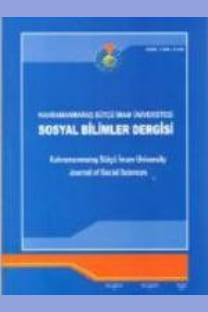Nebevî Beyânda Tasnif ve Tedris Açısından Değeri
Grouping in the Prophetic Declaration and Value in Terms of Teaching
Notification, declaration, classification,
___
- Ahmed b. Hanbel, el-Müsned, İstanbul 1992.
- Başaran, İbrahim Ethem, Eğitim Psikolojisi Modern Eğitimin Psikolojik Temelleri, Ankara 1988.
- Buhârî, Ebû ‘Abdillâh Muhammed b., İsmâ‘îl, el- Câmi‘u’s-Sahîh, İstanbul 1992.
- Canan, İbrahim, Peygamberimizin Tebliğ Metotları 2, İstanbul 2002
- Ebû Dâvûd, Süleymân b. el-Eş‘as es-Sicistânî, es-Sunen, İstanbul 1992.
- Fidan, Nurettin-Erden, Münire, Eğitim Bilimine Giriş, Ankara 1987.
- İbn Mâce, Ebû ‘Abdillâh Muhammed b. Yezîd el-Kazvînî, es-Sunen, İstanbul 1992.
- Müslim b., el-Haccâc Ebû’l-Huseyn el-Kuşeyrî en-Neysâbûrî, el-Câmiu’s-Sahîh, İstanbul 1992.
- Nesâî, Ebû ‘Abdirrahmân Ahmed b,. Şu‘ayb, es-Sunen, İstanbul 1992.
- Özden, Yüksel, Eğitimde Yeni Değerler Eğitimde Dönüşüm, Ankara 2002.
- Selçuk, Ziya, Gelişim ve Öğrenme, Ankara 2004.
- Sönmez, Veysel, Öğretim İlke ve Yöntemleri, Ankara 2010.
- Suyutî, Celâleddîn, Zehru’r-Rubâ ‘ala’l-Muctebâ, Kâhire 1930.
- Şişman, Mehmet, Eğitim Bilimine Giriş, Ankara 2007.
- Tirmizî, Ebû ‘Îsâ Muhammed b. ‘Îsâ, es-Sunen, İstanbul 1992.
- Yeşilyaprak, Binnur (Editör), Eğitim Psikolojisi Gelişim-Öğrenme-Öğretim, Ankara 2006.
- ISSN: 1304-8120
- Yayın Aralığı: 3
- Başlangıç: 2004
- Yayıncı: Kahramanmaraş Sütçü İmam Universitesi
Babil Krallarının Siyasal Meşrulaştırma Aracı: Tanrı Marduk
Haydar İşler, Mehmet Dalkılıç, Mehmet Çoban
Karadeniz'in Kuzeyinde Yer Alan İskit Kurgan Buluntularındaki Savaş Betimlemeleri
İbrahim Ethem TAŞ, Sadegül DURGUN
Avrupa Birliğine Giriş Sürecinde Türkiye’de Laikliğin Paradoksları
Fikret BİRDİŞLİ, Fatma Nur KAÇAR
Paradoxes of Secularism in Turkey in Process of European Union Access
Fikret Birdişli, Fatmanur Kaçar
Mehmet DALKILIÇ, Haydar İŞLER, Mehmet ÇOBAN
The Political and Administrative Situations in Iraq (1932-1958)
Memet Yetişgin, Qasım Mohammed Faraj
Nebevî Beyânda Tasnif ve Tedris Açısından Değeri
İngiliz İdaresindeki Kıbrıs’ın Ermeni İsyanlarındaki Rolü (1878-1908)
